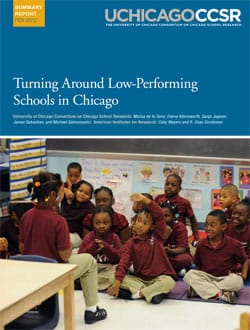 School-turnaround efforts aren’t new. But—thanks in large part to the feds’ latest round of school-improvement grants (SIG) and this week’s CEP report on the program—they’ve recently garnered much press. Unfortunately, precious little is known about whether these efforts (federally funded or not) affect actual student achievement. That research dearth is slowly shrinking. A longitudinal evaluation of Chicago’s turnaround efforts in thirty-six schools between 1997 and 2010 offers good news for the school-turnaround believer. The study, conducted by UChicago’s Consortium on Chicago School Research and the American Institutes for Research, found that, while turnaround results were slow to develop, they were dramatic four years after interventions began—at least at the elementary level: Targeted elementary schools closed the test-score gap between themselves and the system average by half in reading and by almost two-thirds in math. (Researchers were unable to analyze test scores at the high school level, so evaluated attendance and ninth-grade readiness instead; they reported no real improvements for turnaround schools in either.) We’ve long harbored doubts about the efficacy of turnarounds, but this report bangs a slight crack in our cynicism—at least for initiatives that are given multiple years to gain traction.
School-turnaround efforts aren’t new. But—thanks in large part to the feds’ latest round of school-improvement grants (SIG) and this week’s CEP report on the program—they’ve recently garnered much press. Unfortunately, precious little is known about whether these efforts (federally funded or not) affect actual student achievement. That research dearth is slowly shrinking. A longitudinal evaluation of Chicago’s turnaround efforts in thirty-six schools between 1997 and 2010 offers good news for the school-turnaround believer. The study, conducted by UChicago’s Consortium on Chicago School Research and the American Institutes for Research, found that, while turnaround results were slow to develop, they were dramatic four years after interventions began—at least at the elementary level: Targeted elementary schools closed the test-score gap between themselves and the system average by half in reading and by almost two-thirds in math. (Researchers were unable to analyze test scores at the high school level, so evaluated attendance and ninth-grade readiness instead; they reported no real improvements for turnaround schools in either.) We’ve long harbored doubts about the efficacy of turnarounds, but this report bangs a slight crack in our cynicism—at least for initiatives that are given multiple years to gain traction.
Marisa de lat Torre, Elaine Allensworth, Sanja Jagesic, James Sebastian, and Michael Salmonowicz, Turning Around Low-Performing Schools in Chicago (Chicago: Consortium on Chicago School Research, February 2012).
